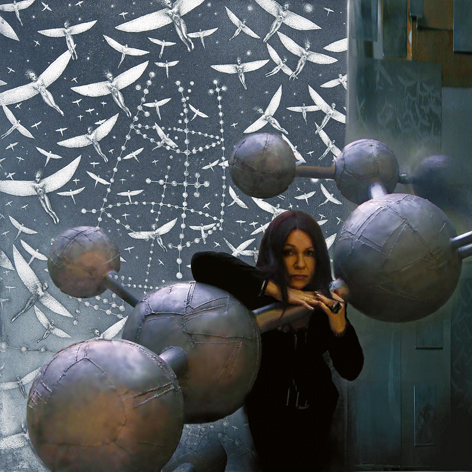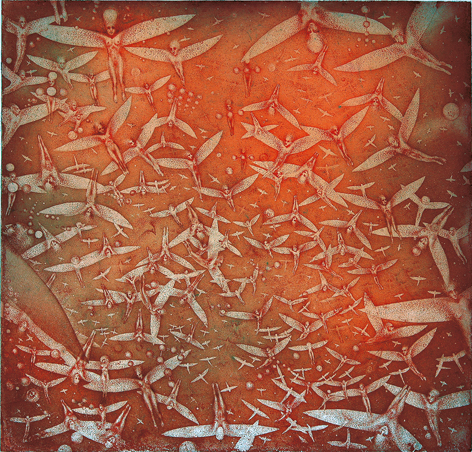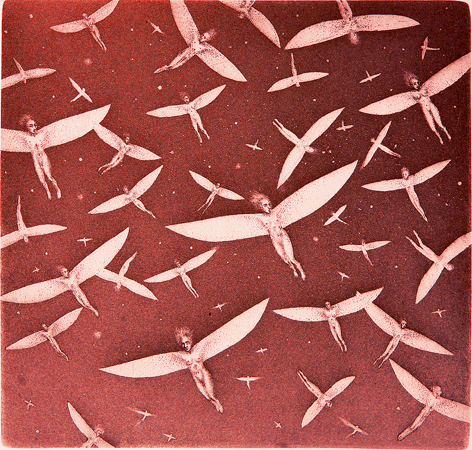|
|
| Inside Her Own Reservoir of Time Aiga Dzalbe, art historian Nele Zirnīte. "Laika rezervuārs" 11.07.-16.08.2009. Latvian National museum of Art | |
 Nele Zirnīte. 2009. Photo: Jegors Rostovs | |
| I met with Nele Zirnīte in her new workshop in the basement of the Artists Union. The printmaker was preparing for her exhibition at the White Hall of the Latvian National Museum of Art. She seemed tired, surrounded by her numerous beautiful works, rummaging through them, trying them out in their frames and visualizing them at the exhibition. Just the kind of situation appropriate to an author who has worked, created and created with a passion, day after day, for more than 25 years. Besides, in Zirnīte's case, we must take into account the fact that her work is as powerful as it is finely wrought, and that over the years the imaginative motifs of her works have become intertwined into unfathomable connections. Nele Zirnīte is a Latvian graphic artist of Lithuanian descent. She was born in the Žemaitija region of Lithuania, in Latvēļi village (Latvēļi is the Lithuanian word for "Latvian" in its diminutive form). She first studied art with the printmaker Leons Lagauskis at the Graphic Art Department of the Vilnius Academy of Art, and finished her graphic art education under the tutelage of Gunārs Krollis in Latvia, where she also got married. Zirnīte captivated audiences in the late 1980s with her delicately toned etchings devoted to the subject of the relationship between the human being and nature, then a very topical theme (the best known of these works being Valdnieks (‘Ruler', 1988), Zaļais rāmis (‘Green Frame', 1989), Lūgšana (‘Prayer', 1988), Quo vadis (1987)). These are works that have stood the test of time, and one is taken over by a wish to examine them closer, perhaps with a magnifying glass, to discover ever new and unexpected turns, and from that gaining food for thought and a feast for the eyes. The tiny and elaborate forms came about due to quite mundane reasons: like many other artists, she had to work at home, looking after the children. That is where Zirnīte cultivated her etching technique of minute, filigree details. | |
 Nele Zirnīte. Perichoresis 1. Etching, aquatint. 49x52cm. 2004. Photo from the Nele Zirnīte's private archive | |
| In the 1990s the artistic expression of the artist seems to have taken on added depth: the images appear to be more defined, the compositions - more abstract, the background - more saturated. "The etching plate is black; everything has to be drawn in mirror image. To an extent it is a meditative process, which helps me. The biggest treasure is the plate, not the printed pages. Moments of surprise and sorcery. You are creating as if blindfolded, completely immersed within yourself, completely open to yourself. The concentration that is needed in graphic art differs from that which is needed in painting, for example. No matter how emotional and how open you are, you must have the ability to contain within yourself what you wish to convey. There is outward spontaneity, and there is also inner spontaneity. Printmaking demands a period of reflection, "anything goes" is curbed - "so that the work is worth reproducing", says the artist. The works Liesmojošais lietus (‘Flaming Rain', 1995), Mija (‘Alternation', 1996), Neuzrakstītā grāmata (‘Unwritten Book', 1997), Kauss (‘Chalice', 1997) and others mark the moment when the artist turns to technical discoveries, fusing the materiality that can be achieved with the techniques of both etching and aquatint - the concrete and the cosmically boundless. In her series Nesēji (‘Carriers') she has indulged in the possibilities provided by colours and large forms, using a monotype technique with multiple plates. From the year 2000 onwards the graphic artist has continued to express her personal emotions and world view with virtuoso combinations of various techniques. In the finely worked out compositions, images and symbolic signs traverse from one to another and transform themselves (tiny human figures that are flying or clinging to delicate stalks, molecular bonds, fishing-rods, clocks, trees, circular shapes in any number of interpretations - soap bubbles, haloes, key rings, etc.). When characterizing these images in the exhibition catalogue, Eva Rotčenkova refers to surrealism and magical realism. Right now the artist's mind is particularly preoccupied with an installation which is to be at the centre of her exhibition - a tower of metal plates - the real Laika rezervuārs (‘Reservoir of Time'), which the artist herself writes about: "The number of conquered plates over the years keeps growing... Left behind me - a field of zinc plates and matrixes, which is like a protective metal shield engraved with the signs of time, each of them safeguarding the truth of the moment," and adds: "I enjoy looking at the plates that I have tormented." Our conversation begins while looking at a recently made self-portrait. | |
 Nele Zirnīte. Flight. Etching, aquatint. 19x20cm. 2004. Photo from the Nele Zirnīte's private archive | |
| Nele Zirnīte: I have worked on it a great deal. It was important that it doesn't come out too pretty. To understand which is the right light, to reveal the desirable and to allow the unnecessary to dissipate (and I am not speaking about the tiny wrinkles) - to get the right feeling. At one point it seemed that I had brought the work to perfection, but then one morning I rushed it. That's the way it usually works if you want textures, you must do the "biting" a bit longer. I was into the kind of mood where I already envisioned the orangey finish and sank into the process - I put the plate on the stove, applied turpentine and started to work on it. The temperature must have gone up without me realising, and the wax started melting in front of my eyes, the lines and the pattern started to mingle. Initially the self-portrait was too sharp, I had to go over it twice. That's why it looks so peculiar... When I was working on a self-portrait in the 80s, I experienced a similar mishap: at that time the "biting" didn't work, didn't etch at all. It seemed as if everything had been carried out precisely; I washed the face on the plate, and saw - nothing. I wonder why? Aiga Dzalbe: You've only done two self-portraits? N.Z.: There was another one. This is the third etching. A.Dz.: Did you do it from a photo or from the mirror? N.Z.: It was a photo taken by my friend Igors, but I told him what the setting had to be. I already had the etching in mind. A.Dz.: In your works everything is so light, fragile, floaty, the images are airborne, the compositions are like imprints of heavenly or imaginary scenes. The viewers in their freedom of in-terpretation can see in these works all kinds of adventures of the soul. Can you tell me what exactly these images are? N.Z.: It's not so easy to express it concretely in literary terms. It's a kind of state of being... I wouldn't say that I am flitting about all the time, but the thing is, that during the creative process we discover what draws us. I don't think that I would be able to and wouldn't want to depict a composition where people are standing, or actively doing something. A.Dz.: But when you were studying, you had to do it, didn't you. Did it work? N.Z.: Yes, but already then I chose compositions where only a part of a person was depicted, perhaps down to the waist, a head in the foreground, or something like that. There must have been some works that I created in the spirit of realism. But even in my graduation work the composition was freely filled with images. This is for a psychologist to explain. A.Dz.: So you just pull out images from the unconscious and don't even try to explain them? N.Z.: Yes, they are based on feelings. My works may have some elements that don't exist in reality, but they reappear in several of my graphics. It's like a leitmotif that changes, grows into something else, different from what it was initially, for example, the halos that I unconsciously keep transforming. Those shapes, those feelings... I sketch a lot, but I don't always draw the compositions - I see them and make variations in my mind's eye. This year, for example, the halos showed up in my works as flaming circus hoops (I didn't even know that it was year of the circus, until I heard Heimrāts mention it in relation to the Art Days). These hoops could be made into a series. It's interesting for me to observe how in some works the hands merge with the flaming hoop, in some of them the hands catch fire, and in others they don't. Usually hands and the look in the eyes are important in my work, but the newest works don't have that look; the emptiness has become interesting. This is also true of the self-portrait. Usually authors try to complement the look in their eyes, but my face is surrounded by empty flying hoops. A.Dz.: To me they look a bit like small hand mirrors. N.Z.: Perhaps, but the smaller ones also remind me of the male gender symbol - the circle with the arrow. The images come to life un-noticed. You may remember the work Saišķis (‘Bunch'), where people were depicted as keys on a ring, hanging onto the ring by their hands. But that was something else... A.Dz.: Do you find it interesting to imagine what the viewer might perceive? N.Z.: The interpretations can be quite unexpected. Sometimes they are very precise. Since I posted a gallery of my works in the online portal Draugi, I have received many comments from people I don't even know. There was one girl who commented on my work so beautifully: "...I have never before come across that kind of red: so subdued, and at the same time so richly saturated, an unknown red... you have to come very close to it, be right next to it, to understand and feel it. Each work has a story that opens the soul deeper and deeper, takes it over and unbinds it...". I really feel that I have touched and moved this person, and besides, I think that her perception is very precise, emotional and similar to mine. In reproductions people usually imagine that the works are larger, and with different nuances. Last year I encountered a very emotional response at the Nexus solo exhibitions in Lithuania, where some people had tears in their eyes, and they wanted to talk on and on, standing next to my works. The well-known Lithuanian philosopher Jurate Baranova put it very nicely: "When an artist asks a philosopher, what do you see in my works? - the philosopher can afford to share a few of the impressions. That's what I do, right into Nele's ear, but so that others can hear it too. Because society is the only meeting place for the artist and the writer. The German philosopher Leibniz once said that the world consists of many mutually unconnected monads. The artist perceives things like that by intuition... A closed face, immersed in thought - that is a visualized monad. I don't know if it's Leibniz-y. Perhaps Nele-y. Contemporary. But it still tells a story about the human life eternally doomed to loneliness...". A.Dz.: In the text by the exhibition curator Eva Rotčenkova you can read a professional and thorough interpretation of your works. How does that feel? N.Z.: That's interesting, I haven't read it, yet. But I did tell Eva about everything, about each one of my works. A.Dz.: When being here, among all your life's work, is it easy to see and to separate the different periods, the cycles in your creative work? N.Z.: I've never had such a comprehensive exhibition in a museum until now. You have to take a look from the sidelines. But it is almost impossible to separate the works, because the ideas of one work may reverberate 15 years later in another. Each work has other works in tow. Obviously even my thinking is cyclical. Previously the themes and cycles used to crystallise slowly, but now my head is full of ideas. Physically I don't have the time to realize it all. I finish one work, but I feel like several works on the same theme are ready. Interestingly, my most recent works often remind me of the very early ones, I would like to achieve that same fineness again. A.Dz.: How long does it take to create a work? N.Z.: A terribly long time. Previously I wasn't so demanding. Now there is always something wrong, something must be adjusted. In my mind I see the work as much more complete. Months, or a whole year can pass before the work is ready. In the process I might discard 10 of the impressions, which is also financially difficult. I never work with straight typographic tints, I clearly know what colour scheme I want. I want to achieve tonal precision, all the possible tonal gradations, which is very complicated and time consuming. Besides, it requires a lot of patience. Now I also like to create works of varied scale. Earlier, without this professional maturity, it was always interesting to learn something new. But now it seems that I have gone through all the technical finesses, and have arrived at the necessary technical minimum. And I am so picky with the students at the Christian Academy. When I am teaching them, I feel that I know the limits that can be reached in each technique; I visualize the work in its ideal execution. A.Dz.: To what extent are you involved in public activities? You are member of the board of the Artists Union, and the organisation Grafikas kamera is a result of your efforts. N.Z.: In truth, I am not interested in it, what is behind all that is the awareness that someone has to take care that the graphic art workshops with the printing equipment won't disappear, won't be lost. Besides, it seems important to me to gather together those who think alike and to keep the workshop active and open. I believe that it would be foolish to destroy it. I feel involved, I can't turn my back on it all. Probably I am a rational person. And I really like to take a disused space, and from nothing create something that is vitally necessary to so many. Now I'm working on a new international project Aqua Forte (that is the name of the acid which is used in etching), which will start next spring with open workshops. The goal is to hold a printmakers' exhibition. Nele Zirnīte Born 1959, Lithuania. 1978-1982 studied at the Vilnius Academy of Art 1984 graduated from the Latvian Art Academy, Graphic Arts Department (MA in 2000). Has been participating in exhibitions since 1982. Solo exhibitions - in Latvia, Lithuania, Estonia, Germany and the USA. Regularly participates and triumphs at international triennials and biennials (e.g. 1st Prize (top prize) at the "Josep de Ribera" 9th International Biennial of Engraving, Xativa, Spain (2007) or the Grand Prix at the Biennial of Small Graphics, GRAFIX, Breclav, Czech Republic (2005)). Her work is included in the prestigious publication ‘The Best of Printmaking: An International Collection' (1997), which features 250 of the best printmakers from around the world. /Translator into English: Vita Limanoviča/ | |
| go back | |







